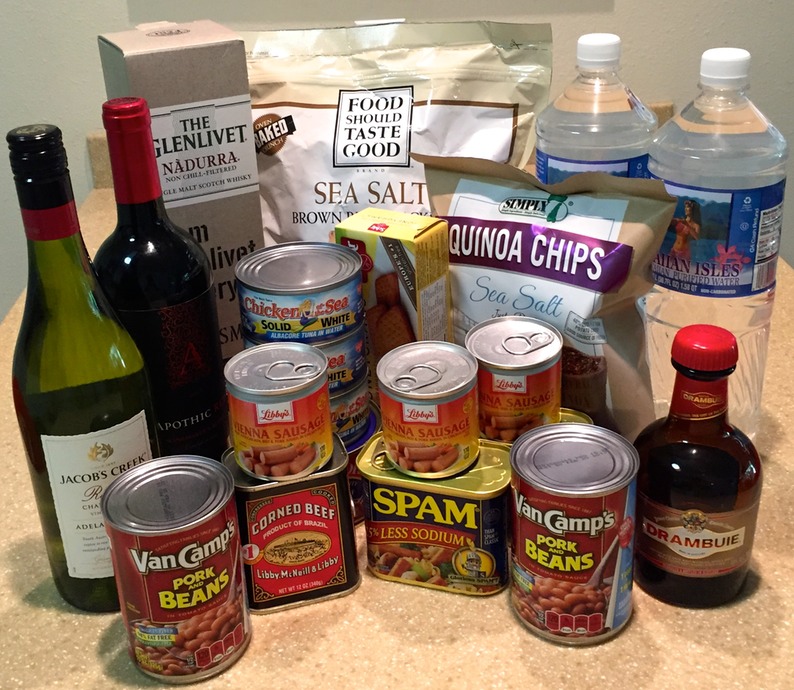Blog
Keep it or toss it?
So, it’s summer (SPF 30, everyone) and with it comes the start of hurricane season. Out here in the Central Pacific, NOAA said that we have a 70 percent chance of an above-normal number of hurricanes (five to eight) this year. Thanks, El Niño. The past few years we’ve been lucky, with a few glancing blows that left some damage in its wake.
The last time we had a direct hit on the Hawaiian Islands was when the category 4 hurricane Iniki came roaring through and left the island of Kauai devastated. This was on September 11, 1992. The one before that was the category 1 hurricane Iwa in 1982. You do the math. We are so overdue. So, it’s time to check out our hurricane emergency stores, and especially our food and water supply (the one from last year that we’ve been trying to consume since the season ended in November).

If you prefer fresh food as we do, how many cans of Vienna sausage, Spam, corned beef, tuna, baked beans and what not can you consume? Never mind the stacks of bottled water. So much easier to push a button and get chilled, filtered water straight from the frig.
As I inspected last year’s supply, I got to thinking about food safety. When was the last time we checked the “use by” dates on our stored cans and packages? And how about the unlabeled stuff? Are they safe? Should we be chucking them out? In fact, what do we know about what’s really safe to eat?
As luck would have it, I just had a conversation with one of the folks at Aloha Harvest for a work related project. They’re the people who “rescue” perishable and non-perishable foods that would otherwise be discarded by food distributors, stores, restaurants, hotels, and other businesses because they’re excess stock or too close to their expiration dates. Aloha Harvest doesn’t store the food, but delivers them to social service agencies the very same day the donations are picked up so that they can be distributed to the hungry without delay.
I wondered, given the nature of most of the donated foods, how does Aloha Harvest know which are still safe to consume, especially when some of them may be near their expiration dates? My new friend immediately disabused me of the belief that “use by” or “best by” dates mean that a food is not safe. It turns out that this is the manufacturer’s code for telling you how long the product is likely to remain at its pristine, pretty best when unopened. After that date, you may start to see small changes in the texture, color and flavor of the food, but it’s not a safety date, according to the U.S. Department of Agriculture. The way to check for safety is to smell the food in question and examine it. If it’s funky, toss it.
Rather than do the sniff test, I’m going to check the handy website that Aloha Harvest uses – www.stilltasty.com. It bills itself as “The Ultimate Shelf Life Guide,” and gives you the lowdown on what you should keep or toss. Since they get their information primarily from the USDA, the U.S. Food & Drug Administration and the U.S. Centers for Disease Control and Prevention, plus other food safety research organizations, I’m inclined to trust them.
So, I did a quick browse and found some interesting facts – not all hurricane food related.
Eggs – They’re perfectly safe for about 3 to 5 weeks after their expiration date (that surprised me), as long as you keep them well refrigerated. After that, you best bet is to freeze them. They even tell you how.
Bottled water – I didn’t know there was a “best before” date on bottled water. But not to worry. It’s good indefinitely as long as the bottles are unsealed and undamaged. After a long while, the smell or taste way change but it’s still safe to drink. Guess I’ll hang on to my left over emergency supply.
Storing canned food leftovers in the can – Is it OK? If you’ve been known to do this (how inelegant of you), don’t worry. It’s safe to refrigerate canned foods manufactured in the U.S. directly in the can. But they don’t advise it, as the food will likely lose its flavor and appearance. Don’t be lazy. Store the leftovers in a tightly sealed glass or plastic container.
The “Expires on” date – Parents, listen up! The only place you’ll see this date is on baby formula and some baby foods. The federal government recommends that you use these products before the expiration date. They’re the only food products that the feds regulate with regards to dating.
Some foods that last forever – As long as they’re stored properly, they’ll last for years, sometimes decades, even after they’ve been opened:
· Honey
· Rice
· Sugar
· Hard liquor (I could have told you that!)
· Maple syrup
· Pure vanilla extract
· Distilled white vinegar
· Cornstarch
· Salt
I’d say none of these are vital for your hurricane food supply. Well, except for the hard liquor. And maybe rice, if you have a gas stove or grill handy. Then you’ve got Spam and rice in a pinch!
Here’s a good tip in case of a power outage. If you keep you freezer full, it will hold food safely up to 48 hours – twice as long as if it’s only half full. If you don’t have enough food to store, fill up some plastic jugs with water and freeze. Then hope your power is restored within 48 hours.
O.K., Central Pacific peeps. Enough hot tips for you. Time to get serious and gather up your hurricane emergency supplies. Here’s a really detailed list of everything you may need -- just in case.
A Carib storm god,
Hurican* is on the prowl.
Keeping fingers crossed.
*According to the Hurricane Research Division of NOAA, the word “hurricane” is derived from “Hurican,” a Carib god. This, in turn, was derived from the Mayan god “Hurakan,” one of their creator gods “who blew his breath across the chaotic water and brought forth dry land and later destroyed the men of wood with a great storm and flood.”

